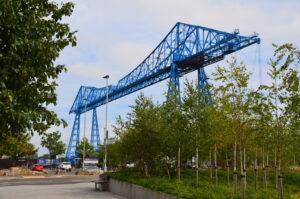Carbon, construction and the climate crisis: what role does procurement play?
 In order to stand any chance of meeting the UK government’s targets, 100% of all new buildings must be designed to be zero-carbon within the next five years, and 100% of all new buildings constructed must be zero-carbon within the next decade. Procuring new developments through effective framework agreements is one way of moving more swiftly to a zero-carbon circular economy, so says Jason Stapley, managing director at Pagabo.
In order to stand any chance of meeting the UK government’s targets, 100% of all new buildings must be designed to be zero-carbon within the next five years, and 100% of all new buildings constructed must be zero-carbon within the next decade. Procuring new developments through effective framework agreements is one way of moving more swiftly to a zero-carbon circular economy, so says Jason Stapley, managing director at Pagabo.
Over the next 40 years, the world is expected to build 230 billion square metres of new construction, adding the equivalent of Paris to the planet every single week. This means that we must act now to meet the challenge of building net-zero developments not just to meet government targets in the UK, but also to create a better future for every person on the planet.
The first challenge is the understanding of what the move to carbon neutrality means from a construction point of view.
The London Energy Transformation Initiative’s (LETI) Climate Emergency Design Guide revealed that 49% of annual carbon emissions in the UK are attributable to buildings, that all new buildings must operate at net zero-carbon by 2030, and all buildings must do the same by 2050.
However, when discussing carbon neutrality in construction more education is still needed. Achieving net-zero is not simply about the construction phase, it is about whole life carbon effect.
The carbon footprint of any building is made up of a combination of embodied and operational carbon – i.e. producing a building’s materials, their transport and installation on-site, as well as their disposal at the end of life, and how the building is run operationally following occupation, including maintenance, repair and replacement.
Whole-life cost is the second big challenge. It’s imperative that those people understand that building something now doesn’t mean building something for themselves. While they may use the building in the short term, they are really constructing something that will be there for several decades at least – so they are building for future generations.
So, it’s not about a race to the bottom and building the cheapest now. We must examine how we don’t just ‘hit’ targets but exceed them for future benefit.
Simply put, if we invest our money into better quality materials, processes and techniques now, there will be a greater benefit down the line. We must remember that end of life can provide significant input into the level of the embodied carbon of a building as well, whether it be a mechanical refit, refurbishment or demolition.
Timber construction is an area we are seeing develop quite rapidly – for example, planning was granted late in 2019 for the world’s first wooden football stadium for Forest Green Rovers. Using timber for developments where possible can reduce carbon emissions related to practical completion but would also result in a drop of operational emissions as well.
The lifespan of any building is several decades before any major maintenance work will need to be done, and – not surprisingly – evidence shows that carbon emissions jump during the lifespan of any building when major regeneration works needs to be done. If we design and build to the best achievable levels right now, we could eliminate the need for major replacement and maintenance before a building’s end of life.
Many organisations are calling for the coronavirus recovery to be a green one, providing a springboard for longer-term change.
The Committee for Climate Change published its 2020 progress report to Parliament in June on the efforts to reduce carbon emissions in the last year, highlighting key investment priorities for the coming months including the strengthening of the energy network, improved infrastructure for walking, cycling and remote working, low carbon retrofits and a rapid move towards a circular economy.
As well as this, the Committee also identified opportunities to support the transition and recovery by investing in the UK’s workforce and in lower carbon behaviours and innovation through reskilling and retraining programmes, and targeted science and innovation funding. With less than five years to be designing at a fully net zero-carbon level, it’s crucial that we do all we can to not just change attitudes, but behaviours as well.
However, for all the conversation around zero-carbon builds, we must examine the fact that operational carbon levels are likely to be higher than embodied levels over the lifespan of a building. Changing attitudes and introducing energy efficiency will be a gamechanger. Many people are already waking up to the global crisis we are facing – and the coronavirus pandemic has helped with some of this general climate change education as we saw global air pollution fall during lockdowns.
Research conducted by Energy UK with PwC showed that there was a 15 to 20 per cent reduction of energy demand during the UK’s lockdown period when compared to the same period in 2019, and evidence has shown that 30 per cent of consumers are paying closer attention to their energy usage since working remotely. Homeworking has also seen a flattening in daily peaks of energy usage in the domestic market.
The government is working hard towards its election promises to build at least a million new homes by 2025, and with the workforce expecting greater flexibility in home working options post-COVID, the housing market is an important area for driving towards better energy efficiency for tenants and lowering carbon contributions.
Energy UK’s report showed that the reduced energy demand during lockdown meant that 40 per cent of energy supply came from variable renewable generation in April 2020. If we design our buildings in the most effective way now, these are the kinds of benefits we will be able to continually reap in the near future. One major area of work identified by LETI that will need to be done in the UK specifically is our use of heat in the winter – and as summer heatwaves increase in frequency, we will see increased electrical usage for keeping cool too. Simply put, our housing stock needs to work harder so that our utilities don’t need to.
In the emergency summer budget at the beginning of July, the Chancellor confirmed a £3bn green jobs plan, with £2bn being spent to subsidise households their homes more energy efficient, and a further £1bn being used to fund the energy efficiency of public sector buildings.
But where do framework providers come into the picture?
Simply put, as the UK government is committed to achieving net-zero carbon emissions by 2050, everything procured via framework agreements will have to meet these requirements.
At Pagabo, we are passionate about creating a better future for all, and we have clear requirements for sustainability for those applying to be on our frameworks. As well as this, zero-carbon aims are laid out during the initial procurement stages of any project to ensure that the best possible work is being made from day one when it comes to sustainable development.
We have seen clients continuing to progress – and even accelerate – the design phase during the pandemic, so it’s of critical importance that these accelerated projects still meet the necessary requirements of a carbon-neutral development.
Frameworks need to perform differently post-COVID in a variety of ways, particularly to help realise government objectives. Working with clients and supply chain alike towards a circular economy through expert guidance will be one of the central roles that companies like ourselves will need to play.
In its ‘Project Speed’ package, the government has already laid out its plans to ‘build back better’ and ‘build back greener’, but it’s crucial that everyone across the construction sector in particular pulls together to make sure that happens.
For more information about Pagabo and its frameworks, please visit https://www.pagabo.co.uk/.















